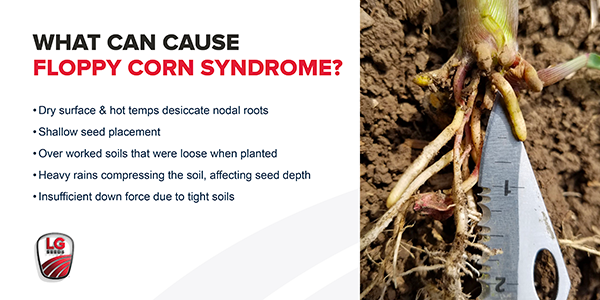AGRONOMICSUPPORT
YOU CAN TAKETO THE FIELD
Floppy Corn Syndrome: The Issue, Cause, and Fix
The seat that’s only 14.2” wide. The lap bar that’s bruising your legs. The way-too-tight seatbelt.
Getting cinched into a roller coaster isn’t exactly fun. But as your car twists, turns, jumps, and dives, and you flop around like a pool noodle, you realize being firmly rooted is pretty important—especially when conditions get a bit dicey.
And the same could be said for corn…
Floppy Corn Syndrome: Problems Below the Surface
Floppy corn syndrome (sometimes referred to as “rootless” corn syndrome) occurs when corn plants are not firmly rooted in the soil.
And just like the roller coaster that seemed relatively harmless at first, looks can be deceiving.
Corn suffering from this syndrome may be dark green, seemingly healthy, and have decent height. But as soon as a wind storm pops up, the corn flops right over.
Floppy corn syndrome is usually an early-season issue (V2-V5), and the drought conditions across the Corn Belt have made it a little more prevalent this growing season.
FCS: The Issue
After your newly planted corn germinates, the plant first develops seminal roots. As it emerges, nodal roots develop, beginning at about ¾” above the seed. It’s these roots that will help your corn with primary support and nutrient uptake.
But if the soil just below the surface gets hot and dry, those nodal roots can shrivel up and die. When the wind picks up, the corn flops over.
If your corn flops, it’ll usually still look relatively healthy. But corn on the ground will often lower your yield and ROI. Plus, navigating a combine through a field of bent corn will likely slow your harvest.
FCS: The Cause
As mentioned, floppy corn syndrome occurs when those early nodal roots desiccate in hot, dry soil and can no longer support the plant’s weight.
But what leads to these conditions?
Well, it’s kind of a mixed bag.
Hot and Dry Soil: This makes sense. Lack of rainfall and high temps (like we’ve seen this year) dry up the soil, and the roots die. But too much rain isn’t great, either.
Lots and Lots of Rain: Major downpours can wash away topsoil. When this occurs, the seed is effectively shallower than it should be, and the roots are more susceptible to heat damage. Cue cause #3.
Improper Planting Depth: This is a biggie. Properly adjusting your planter for each field is vital. If you plant too shallow, the roots are at risk (planting too deep can cause similar problems!). Certain practices and conditions can make this issue more likely. If you’re overworking the soil and planting into a field of fluff, you’re asking for erosion issues, thus shallow seeds. Furthermore, planting into muddy or compacted fields can result in shallow seeds and weak roots.
Note: Don’t blame floppy corn on herbicide applications. Although you may have been told this before, there’s really no evidence to back this up.
FCS: The Fix
Unfortunately, there’s not much you can do once your corn flops. But you may be able to prevent it (to a point).
First and foremost, customize your planting depth for each field and condition. Having your planter in good working order is your best bet.
If conditions look like FCS could become an issue, cultivating between rows can sometimes stimulate nodal root growth… but cultivating in downed corn (or in a no-till system) is obviously a bit of a problem.
And, of course, rain (in the proper amounts at the right time) is the best prevention.
LG Seeds is By Your Side
At LG Seeds, we are built for how you grow and are committed to your success. If your corn does flop, you still have the potential for decent growth and a salvageable yield—even if your corn looks like it’s taking a nap.
Reach out to your LG Seeds agronomist today for help preventing or dealing with floppy corn syndrome on your farm.






Agronomy Team